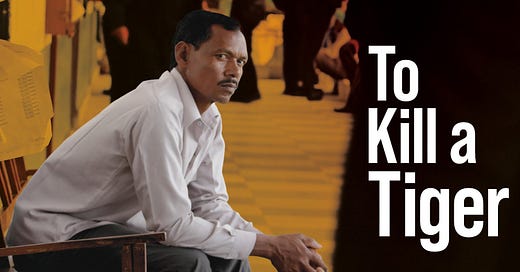Now in Theaters — To Kill A Tiger, Powerful Documentary
Inspiring and Thoughtful In An Age Of Voyeuristic True-Crime
Can a family, and in particular, a father, achieve justice for his daughter in the face of powerful forces like social ostracization and glacial bureaucracy? To Kill A Tiger, a documentary by Nisha Pahuja, tracks Ranjit and his family thoughtfully and respectfully, and notes the interplay between human agency and social, institutional dynamics.
You may feel a bit hesitant about going to watch this film, as I was, because of its subject-matter: the film tracks the fallout following the violent sexual assault of a young girl in rural Jharkand. Let’s see if you have the same questions as I did?
Question 1 — Is this another ‘true-crime’ production that profits from trauma and gratuitous violence?
This isn’t that.
Question 2 — Is this another Western-gaze oriented film that uses sexual violence to make racist assumptions about India?
This isn’t that either.
Question 3 — Is this a poverty glorification / romanticization project where rich do-gooders make prescriptive decisions about what disenfranchised people should do?
No.
Still, it’s fair for people who have consumed a lot of India-related content to ask these questions. But the film avoids these traps and instead focuses on using its rectangular, moral eye to frame important questions and tell a moving, human story.
I could write at length about the following things:
The extraordinary strength of the survivor.
The extraordinary strength of her father and mother.
But instead, this post is going to focus on a choice made by the filmmaker that I’m really thankful for:
The camera acknowledges itself, and the documentary crew, and their impact on the unfolding of the story.
This is very important because statistically, very few victims of this type of assault come forward, very few cases move through the bureaucratic morass to a successful conclusion, and very few perpetrators face meaningful consequences. Therefore, if the documentary crew were to efface their own presence, it might suggest that this fantasy of justice is achievable.
Instead, it seems that Ranjit and his family achieve justice in part because he’s able to wrangle both the NGO (Srijan Foundation) and the documentary crew in such a way that he successfully obtains his desired outcome using the implicit power of media, wealth, Ranchi, Mumbai, Canada to fight the forces of his local village bullies and normal torpid bureaucracy.
The title To Kill A Tiger comes from an idiom that implies that for a villager in India to survive, they must have the support of the village. It’s used by the village to urge the father to give up on his fight for justice and to make a compromise with the perpetrators’ families for the sake of village harmony.
But Ranjit succeeds in killing a tiger with the help of Mindy Kaling and Dev Patel! He makes a gamble (he is, in fact, a gambling man), allying himself with Ranchi and the larger world against his smaller world, and the gamble, happily for him, has historic consequences. It’s a win-win-win. He gets justice. The filmmakers get an incredible story with likable, inspiring characters. That part of India gets a landmark case precedent that can genuinely inspire families to stand by their daughters.
Other Things I Like About The Film:
The scenes with discussion about ‘kalank’ and ‘daag’ (the words mean ‘stain’) and the importance of standing and izzat (respect). These are brilliant scenes that allow the characters, no matter how reprehensible a Western liberal mind might find their views to be, to at least articulate their own worldview. Nisha Pahuja and the mind behind the camera, engage without judgment while also retaining a moral compass and sense of right and wrong with respect to the survivor.
The sheer, electric drama of bureaucracy! I was losing my mind during the scene where the Ward Member is off walking somewhere instead of giving evidence. The music goes up a notch! The film transforms this ordinary, quotidian, legalistic moment into high drama. It’s The Wire in India and it’s electrifying.
There is a moment when the camera crew is in genuine danger and those of us who know anything about Jharkand know that this isn’t imagined or unreal. But the documentary doesn’t ham it up like it’s Vice reporting; they don’t center their own story. Rather, the scene emphasizes the pressure this family faces from the local community.
This is a special film. Yes, it’s potentially very distressing and you should avoid it if you can’t handle the content. Honestly, I was scared to go but it was not a film that lingered in trauma; it moved through trauma and I felt that it processed it rather than getting stuck in it. That’s an achievement in itself.
Please check showtimes in your cities and get out to it if you can.
— Raghav




